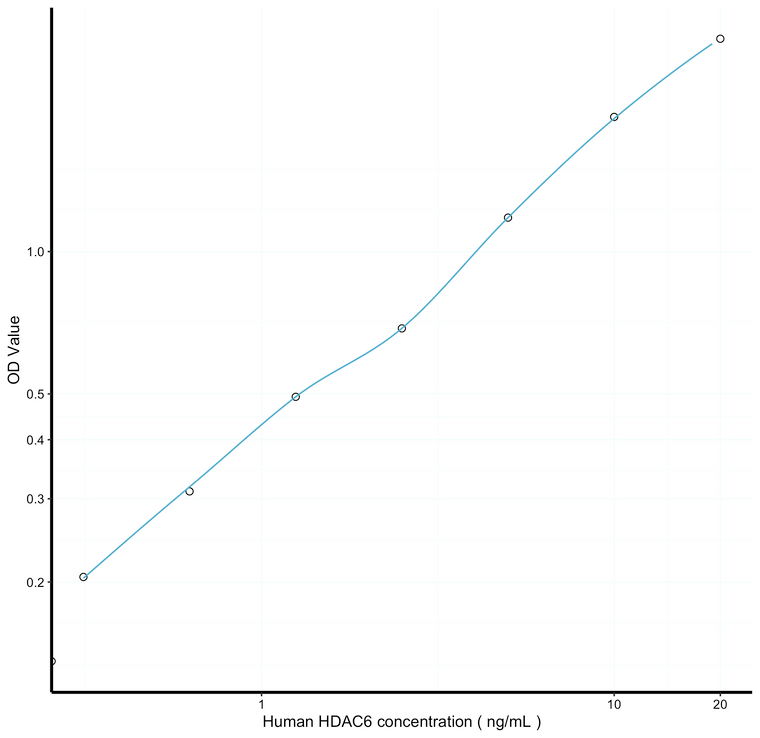| Applications: |
ELISA |
| Reactivity: |
Human |
| Note: |
STRICTLY FOR FURTHER SCIENTIFIC RESEARCH USE ONLY (RUO). MUST NOT TO BE USED IN DIAGNOSTIC OR THERAPEUTIC APPLICATIONS. |
| Sensitivity: |
0.114ng/mL |
| Detection Limit: |
0.312-20ng/mL |
| Short Description: |
This HDAC6 Sandwich ELISA Kit is an in-vitro enzyme-linked immunosorbent assay for the measurement of samples in human cell culture supernatant, serum and plasma (EDTA, citrate, heparin). |
| Storage Instruction: |
Store the unopened kit in the fridge at 2-8°C for up to 6 months. Once opened store individual kit contents according to components table provided with the kit. |
| Assay Time: |
4.5 hrs |
| Gene Symbol: |
HDAC6 |
| Gene ID: |
10013 |
| Uniprot ID: |
HDAC6_HUMAN |
| Sample Type: |
tissue homogenates, cell lysates or other biological fluids. |
| Tissue Specificity | |
| Post Translational Modifications | Phosphorylated by AURKA.phosphorylation increases HDAC6-mediated deacetylation of alpha-tubulin and subsequent disassembly of cilia. Ubiquitinated. Its polyubiquitination however does not lead to its degradation. Sumoylated in vitro. |
| Function | Responsible for the deacetylation of lysine residues on the N-terminal part of the core histones (H2A, H2B, H3 and H4). Histone deacetylation gives a tag for epigenetic repression and plays an important role in transcriptional regulation, cell cycle progression and developmental events. Histone deacetylases act via the formation of large multiprotein complexes. In addition to histones, deacetylates other proteins: plays a central role in microtubule-dependent cell motility by mediating deacetylation of tubulin. Required for cilia disassembly.via deacetylation of alpha-tubulin. Promotes deacetylation of CTTN, leading to actin polymerization, promotion of autophagosome-lysosome fusion and completion of autophagy. Involved in the MTA1-mediated epigenetic regulation of ESR1 expression in breast cancer. Promotes odontoblast differentiation following IPO7-mediated nuclear import and subsequent repression of RUNX2 expression. In addition to its protein deacetylase activity, plays a key role in the degradation of misfolded proteins: when misfolded proteins are too abundant to be degraded by the chaperone refolding system and the ubiquitin-proteasome, mediates the transport of misfolded proteins to a cytoplasmic juxtanuclear structure called aggresome. Probably acts as an adapter that recognizes polyubiquitinated misfolded proteins and target them to the aggresome, facilitating their clearance by autophagy. |
| Protein Name | Histone Deacetylase 6Hd6Tubulin-Lysine Deacetylase Hdac6 |
| Database Links | Reactome: R-HSA-2122947Reactome: R-HSA-2644606Reactome: R-HSA-2894862Reactome: R-HSA-3371511Reactome: R-HSA-350054Reactome: R-HSA-5617833Reactome: R-HSA-8878166Reactome: R-HSA-8940973Reactome: R-HSA-9613829Reactome: R-HSA-9615710Reactome: R-HSA-9646399 |
| Cellular Localisation | CytoplasmCytoskeletonNucleusPerikaryonCell ProjectionDendriteAxonCiliumMicrotubule Organizing CenterCentrosomeCilium Basal BodyIt Is Mainly CytoplasmicWhere It Is Associated With Microtubules |
| Alternative ELISA Names | Histone Deacetylase 6 ELISA kitHd6 ELISA kitTubulin-Lysine Deacetylase Hdac6 ELISA kitHDAC6 ELISA kitKIAA0901 ELISA kitJM21 ELISA kit |
| output | |
Information sourced from Uniprot.org
12 months for antibodies. 6 months for ELISA Kits. Please see website T&Cs for further guidance







